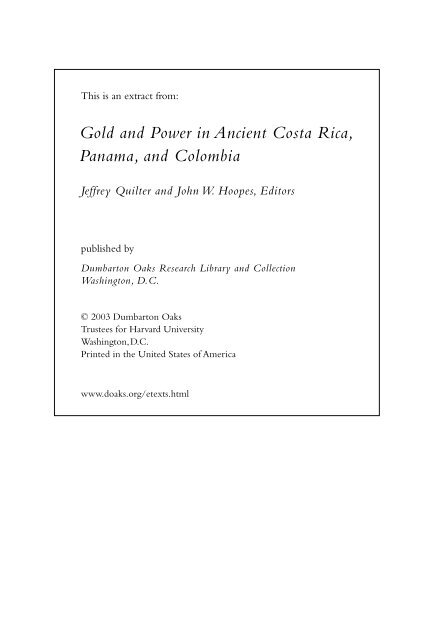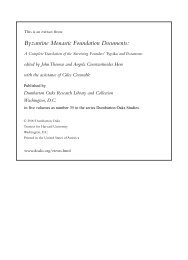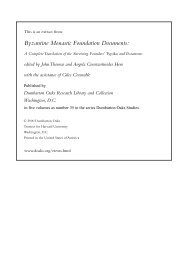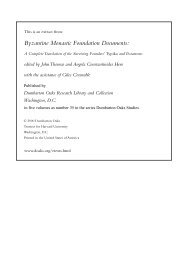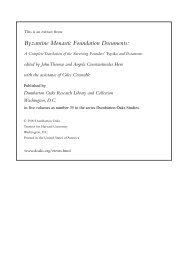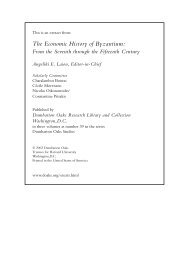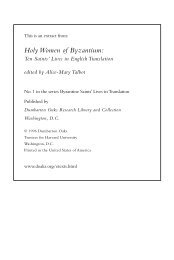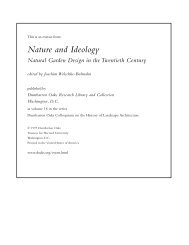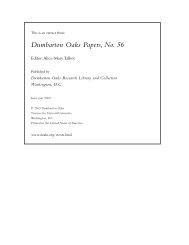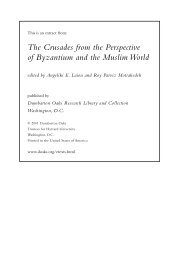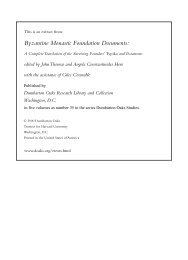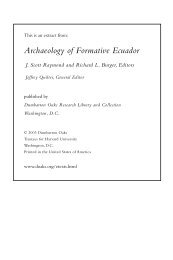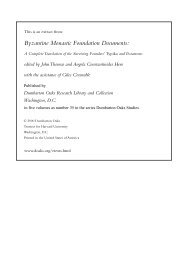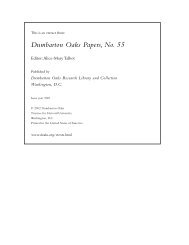Gold and Power in Ancient Costa Rica, Panama ... - Dumbarton Oaks
Gold and Power in Ancient Costa Rica, Panama ... - Dumbarton Oaks
Gold and Power in Ancient Costa Rica, Panama ... - Dumbarton Oaks
Create successful ePaper yourself
Turn your PDF publications into a flip-book with our unique Google optimized e-Paper software.
This is an extract from:<br />
<strong>Gold</strong> <strong>and</strong> <strong>Power</strong> <strong>in</strong> <strong>Ancient</strong> <strong>Costa</strong> <strong>Rica</strong>,<br />
<strong>Panama</strong>, <strong>and</strong> Colombia<br />
Jeffrey Quilter <strong>and</strong> John W. Hoopes, Editors<br />
published by<br />
<strong>Dumbarton</strong> <strong>Oaks</strong> Research Library <strong>and</strong> Collection<br />
Wash<strong>in</strong>gton, D.C.<br />
© 2003 <strong>Dumbarton</strong> <strong>Oaks</strong><br />
Trustees for Harvard University<br />
Wash<strong>in</strong>gton, D.C.<br />
Pr<strong>in</strong>ted <strong>in</strong> the United States of America<br />
www.doaks.org/etexts.html
GOLD AND POWER<br />
IN<br />
ANCIENT COSTA RICA, PANAMA,<br />
AND COLOMBIA
GOLD AND POWER<br />
IN<br />
ANCIENT COSTA RICA, PANAMA,<br />
AND COLOMBIA<br />
A Symposium at <strong>Dumbarton</strong> <strong>Oaks</strong><br />
9 <strong>and</strong> 10 October 1999<br />
Jeffrey Quilter <strong>and</strong> John W. Hoopes, Editors<br />
<strong>Dumbarton</strong> <strong>Oaks</strong> Research Library <strong>and</strong> Collection<br />
Wash<strong>in</strong>gton, D.C.
Copyright © 2003 <strong>Dumbarton</strong> <strong>Oaks</strong><br />
Trustees for Harvard University, Wash<strong>in</strong>gton, D.C.<br />
All rights reserved.<br />
Pr<strong>in</strong>ted <strong>in</strong> the United States of America<br />
Frontispiece: K<strong>in</strong>g Antonio Saldaña of Talamanca wear<strong>in</strong>g a necklace of<br />
tumbaga bird-effigy pendants. Detail of a portrait by S. Llorente, 1892.<br />
©1992 National Museum of <strong>Costa</strong> <strong>Rica</strong>, Editorial Escudo de Oro, S.A.<br />
(Calvo Mora, Bonilla Vargas, <strong>and</strong> Sánchez Pérez, 1992)<br />
Catalog<strong>in</strong>g-<strong>in</strong>-Publication Data for this volume<br />
is on file with the Library of Congress.<br />
ISBN 0-88402-294-3
Contents<br />
Map: Archaeological culture areas <strong>and</strong> contemporary states <strong>in</strong> southern<br />
Central America <strong>and</strong> Colombia<br />
Chronological Chart: Prehistoric <strong>Costa</strong> <strong>Rica</strong> <strong>and</strong> <strong>Panama</strong><br />
Chronological Chart: Prehistoric Colombia<br />
vii<br />
viii<br />
ix<br />
Introduction: The <strong>Gold</strong>en Bridge of the Daríen 1<br />
Jeffrey Quilter<br />
“Catch<strong>in</strong>g the Light”: Technologies of <strong>Power</strong> <strong>and</strong> Enchantment <strong>in</strong><br />
Pre-Columbian <strong>Gold</strong>work<strong>in</strong>g 15<br />
Nicholas J. Saunders<br />
<strong>Gold</strong>work <strong>and</strong> Chibchan Identity: Endogenous Change <strong>and</strong> Diffuse<br />
Unity <strong>in</strong> the Isthmo-Colombian Area 49<br />
John W. Hoopes <strong>and</strong> Oscar M. Fonseca Z.<br />
Who Crafted, Exchanged, <strong>and</strong> Displayed <strong>Gold</strong> <strong>in</strong> Pre-Columbian <strong>Panama</strong>? 91<br />
Richard Cooke, Ilean Isaza, John Griggs, Benoit Desjard<strong>in</strong>s,<br />
<strong>and</strong> Luís Alberto Sánchez<br />
From Jade to <strong>Gold</strong> <strong>in</strong> <strong>Costa</strong> <strong>Rica</strong>: How, Why, <strong>and</strong> When 159<br />
Michael J. Snarskis<br />
Metallurgy, Balls, <strong>and</strong> Stone Statuary <strong>in</strong> the Diquís Delta, <strong>Costa</strong> <strong>Rica</strong>:<br />
Local Production of <strong>Power</strong> Symbols 205<br />
Patricia Fernández <strong>and</strong> Ifigenia Qu<strong>in</strong>tanilla<br />
The Political Economy of Pre-Columbian <strong>Gold</strong> Work: Four Examples<br />
from Northern South America 245<br />
Carl Henrik Langebaek
VI<br />
Creation Imagery <strong>in</strong> the <strong>Gold</strong>work of <strong>Costa</strong> <strong>Rica</strong>, <strong>Panama</strong>, <strong>and</strong> Colombia 279<br />
Mark Miller Graham<br />
<strong>Gold</strong>, Stone, <strong>and</strong> Ideology: Symbols of <strong>Power</strong> <strong>in</strong> the Tairona Tradition<br />
of Northern Colombia 301<br />
Warwick Bray<br />
The Seed of Life: The Symbolic <strong>Power</strong> of <strong>Gold</strong>-Copper Alloys<br />
<strong>and</strong> Metallurgical Transformations 345<br />
Ana María Falchetti<br />
<strong>Gold</strong> <strong>in</strong> the Everyday Lives of Indigenous Peoples of Sixteenth-Century<br />
Southern Central America. 383<br />
Eugenia Ibarra<br />
Index 421
Honduras<br />
CARIBBEAN SEA<br />
Nicaragua<br />
Tairona<br />
Guajira<br />
Greater Nicoya<br />
<strong>Costa</strong> <strong>Rica</strong><br />
Atlantic watershed<br />
<strong>Panama</strong><br />
Lower Magdalena<br />
Darién<br />
Venezuela<br />
Chiriquí<br />
Coclé<br />
S<strong>in</strong>ú<br />
Veraguas<br />
Conte<br />
Middle Cauca<br />
Antioquia<br />
Muisca<br />
Colombia<br />
Or<strong>in</strong>oco R.<br />
Calima<br />
Tierradentro<br />
PACIFIC OCEAN<br />
Upper Magdalena<br />
Brazil<br />
Ecuador<br />
Peru<br />
Amazon R.<br />
Archaeological culture areas <strong>and</strong> contemporary states <strong>in</strong> southern Central America <strong>and</strong> adjacent regions of<br />
South America
Greater<br />
Nicoya<br />
Central Highl<strong>and</strong>s/<br />
Central Pacific<br />
Atlantic<br />
Watershed Diquís Chiriquí<br />
Central<br />
<strong>Panama</strong><br />
1600<br />
1550<br />
Contact Period<br />
Late Ceramic E<br />
1500<br />
1450<br />
1400<br />
Ometepe<br />
Late Ceramic D<br />
1350<br />
1300<br />
1200<br />
Cartago<br />
La Cabaña<br />
Chiriquí<br />
Chiriquí<br />
Late Ceramic C<br />
1100<br />
1000<br />
900<br />
800<br />
700<br />
600<br />
500<br />
Sapoá<br />
Bagaces<br />
Curridabat<br />
La Selva<br />
San Lorenzo<br />
Aguas<br />
Buenas<br />
Late Ceramic B<br />
Late Ceramic A<br />
Middle Ceramic C<br />
400<br />
300<br />
200<br />
100 A.D.<br />
0<br />
100 B.C.<br />
200<br />
Tempisque<br />
Pavas<br />
El Bosque<br />
Aguas<br />
Buenas<br />
La<br />
Concepcíon<br />
Middle Ceramic B<br />
Middle Ceramic A<br />
300<br />
400<br />
500<br />
600<br />
700<br />
800<br />
900<br />
Barba<br />
La Montaña<br />
S<strong>in</strong>acrá<br />
Early Ceramic B<br />
1000<br />
1100<br />
1200<br />
1300<br />
Orosi<br />
1400<br />
1500<br />
1600<br />
1700<br />
Early Ceramic A<br />
1800<br />
1900<br />
2000<br />
Chronological Chart: Prehistoric <strong>Costa</strong> <strong>Rica</strong> <strong>and</strong> <strong>Panama</strong>
Sierra Nevada<br />
de Santa Marta Guajira<br />
Modern<br />
Tairona<br />
Late<br />
Period ?<br />
Late Period<br />
Los Cocos<br />
Poracelli<br />
Neguanje<br />
Early Period<br />
La Loma El<br />
Horno<br />
Malambo<br />
Lower<br />
Magdalena<br />
Modern<br />
Late<br />
Formative<br />
Midde<br />
Formative<br />
Malambo<br />
La Sierra ?<br />
Middle<br />
Cauca Valley Antioquia Muisca S<strong>in</strong>ú<br />
Late Quimbaya<br />
Late Period<br />
Modern<br />
Late<br />
Muisca<br />
Early<br />
Muisca<br />
Malibú<br />
Complejo<br />
Las Palmas<br />
Tradición<br />
Modelada<br />
P<strong>in</strong>tada<br />
Late<br />
Herrera<br />
Pueblo Viejo<br />
Tradición<br />
Granulosa<br />
Incisa<br />
Early Quimbaya<br />
Pueblo Viejo<br />
Ferrería<br />
Early<br />
Herrera<br />
Early<br />
Herrera ?<br />
Upper Magdalena Tierradentro Calima<br />
1600<br />
1500<br />
1400<br />
1300<br />
1200<br />
1100<br />
1000<br />
900<br />
800<br />
700<br />
600<br />
500<br />
400<br />
300<br />
200<br />
100 A.D.<br />
0<br />
100 B.C.<br />
200<br />
300<br />
400<br />
500<br />
600<br />
700<br />
800<br />
900<br />
1000<br />
2100<br />
Before<br />
2100<br />
?<br />
Recent<br />
Regional Classic<br />
Formative 3<br />
Formative 2<br />
Formative 1<br />
Late Period<br />
Middle Period<br />
Early Period 3<br />
Early Period 2<br />
Early Period 1<br />
Sonso<br />
Yotoco<br />
Ilama<br />
Chronological Chart: Prehistoric Colombia
Introduction: The <strong>Gold</strong>en Bridge of the Darién<br />
Jeffrey Quilter<br />
<strong>Dumbarton</strong> <strong>Oaks</strong><br />
Ap<strong>and</strong>emic of gold fever gripped the New World for centuries. Columbus, on his last<br />
voyage, named a strip of l<strong>and</strong> he touched “<strong>Costa</strong> <strong>Rica</strong>” because of the ubiquity of<br />
gold he saw on the necks, arms, <strong>and</strong> chests of its <strong>in</strong>habitants. One of the great tales of<br />
the conquest of Mexico is Cortés tell<strong>in</strong>g Moctezuma’s envoys that the Spanish suffered from<br />
a strange malady for which the only cure was gold (Sale 1991: 233). “<strong>Gold</strong> as cure” may have<br />
been a common Spanish trope. Apparently, once native peoples understood the lengths to<br />
which Europeans would go for this remedy, they occasionally obliged by pour<strong>in</strong>g molten<br />
gold down selected gullets of the “ail<strong>in</strong>g.”<br />
The Spanish did, however, get their gold fix: between 1503 <strong>and</strong> 1660, some 185,000<br />
kilograms of gold flowed from the Americas to Spa<strong>in</strong> (Elliott 1996: 180). If sold at gold’s<br />
current price of $262 an ounce, this plunder would be worth $1,558,023,000; the equivalent<br />
<strong>in</strong> sixteenth-century currency would be more than ten times this amount. <strong>Gold</strong> fueled the<br />
Counter-Reformation <strong>and</strong> the Spanish Armada, alter<strong>in</strong>g the course of world history.<br />
Lust for the yellow metal spread throughout the New World <strong>and</strong> cont<strong>in</strong>ued unabated,<br />
from the sixteenth century (from Columbus to Cortés to Pizarro) through the n<strong>in</strong>eteenth<br />
century (with the California forty-n<strong>in</strong>ers <strong>and</strong> Alaskan gold rushes) to the twentieth century<br />
(<strong>and</strong> the outbreak of gold fever <strong>in</strong> the open pit m<strong>in</strong>es of Brazil). The magical <strong>in</strong>corruptibility<br />
of gold has <strong>in</strong>duced the corruption of many a body <strong>and</strong> soul.<br />
The lure of gold as a source of quick <strong>and</strong> bountiful cash led to loot<strong>in</strong>g on a vast scale <strong>in</strong><br />
southern Central America <strong>and</strong> Colombia. Overgrown ridge-top cemeteries <strong>in</strong> <strong>Costa</strong> <strong>Rica</strong>,<br />
picked clean a century ago, now resemble tropical versions of World War I battlefields, their<br />
surfaces riddled with the pockmarks of looters’ picks rather than mortar shells. Thous<strong>and</strong>s of<br />
gold “eagles” <strong>and</strong> other items poured out of the Intermediate Area to the extent that some of<br />
the smaller pieces were commonly used as watch fobs at the turn of the last century. Despite<br />
these items’ ubiquity <strong>and</strong> the row upon row of bright, sh<strong>in</strong>y objects l<strong>in</strong><strong>in</strong>g museum cases <strong>and</strong><br />
collectors’ cab<strong>in</strong>ets, the number of gold objects scientifically excavated from the region<br />
(exclud<strong>in</strong>g Sitio Conte) could easily fit on a st<strong>and</strong>ard d<strong>in</strong><strong>in</strong>g room table.<br />
Although pioneer<strong>in</strong>g work has outl<strong>in</strong>ed major gold styles <strong>in</strong> Colombia <strong>and</strong> the adjacent<br />
isthmus, much basic <strong>in</strong>formation rema<strong>in</strong>s unknown (Bray 1978; 1981; Cooke <strong>and</strong> Bray 1985;
2 Jeffrey Quilter<br />
Falchetti 1995; Plazas 1978). <strong>Gold</strong> objects stripped of their archaeological contexts lend little<br />
<strong>in</strong>formation about how they functioned <strong>in</strong> society or how styles were spread or modified by<br />
social agents. For example, <strong>in</strong> 1979 Mary Helms proposed a model for the distribution of<br />
gold styles throughout the region. She suggested that seekers of esoteric knowledge who<br />
spent long periods <strong>in</strong> distant l<strong>and</strong>s would return to their homes with gold jewelry <strong>in</strong> exotic<br />
styles as symbols of their newly acquired knowledge <strong>and</strong> status. This, <strong>in</strong> turn, would lead to<br />
the mix<strong>in</strong>g of distant <strong>and</strong> local gold styles <strong>in</strong> the archaeological record. Helms’s <strong>in</strong>trigu<strong>in</strong>g<br />
theory rema<strong>in</strong>s largely untested, however, because local styles cannot be dist<strong>in</strong>guished with<br />
the degree of certa<strong>in</strong>ty necessary to separate foreign from domestic gold <strong>in</strong> terms of design<br />
or alloy composition. A number of chapters <strong>in</strong> this book challenge the Helms theory while<br />
others support it.<br />
Despite the obstacles to study<strong>in</strong>g the social context of goldwork, a considerable amount<br />
of research has been conducted <strong>in</strong> the last three decades (see McEwan 2000), exp<strong>and</strong><strong>in</strong>g<br />
knowledge of the relations between gold <strong>and</strong> the people who made <strong>and</strong> used it <strong>in</strong> ancient<br />
times. Although archaeologists have only excavated one Intermediate Area site with numerous<br />
gold objects (Cooke, Sanchez, Herrera, <strong>and</strong> Udagawa 2000) s<strong>in</strong>ce research at Sitio Conte<br />
(Lothrop 1937; 1942; Mason 1942; Hearne <strong>and</strong> Sharer 1992), many studies directly or <strong>in</strong>directly<br />
relate to gold objects. These <strong>in</strong>clude research on settlement patterns <strong>and</strong> exchange<br />
systems <strong>and</strong> other <strong>in</strong>vestigations that may contribute to new perspectives on social organization.<br />
Studies of prehistoric <strong>and</strong> more recent symbolism <strong>and</strong> ideology offer views on how<br />
gold may have been valued <strong>in</strong> the nonmonetary societies of the ancient New World. Other<br />
research has made significant advances <strong>in</strong> better underst<strong>and</strong><strong>in</strong>g of the languages <strong>and</strong> physical<br />
anthropology of the peoples of Colombia <strong>and</strong> the adjacent isthmus.<br />
A workshop held at <strong>Dumbarton</strong> <strong>Oaks</strong> <strong>in</strong> 1997 explored many of these issues. 1 Discussions<br />
revolved around whether there is enough evidence <strong>and</strong> consensus to designate a new name<br />
for much of what is now termed the “Intermediate Area.” Conferees agreed that recent work<br />
<strong>in</strong> l<strong>in</strong>guistics (Constenla Umaña 1991; 1994a, b) <strong>and</strong> physical anthropology (Barrantes 1993;<br />
1998) strongly support the proposition of long-term occupation of the isthmus <strong>and</strong> adjacent<br />
cont<strong>in</strong>ent by a relatively stable human population. Archaeologists, <strong>and</strong> art historians must,<br />
however, depend upon material culture to marshal arguments for the designation of a region<br />
as a culture area or sphere of <strong>in</strong>teraction. What became <strong>in</strong>creas<strong>in</strong>gly clear at the workshop<br />
was that gold jewelry <strong>in</strong> a dist<strong>in</strong>ctive style range serves as a horizon marker for <strong>Costa</strong> <strong>Rica</strong>,<br />
<strong>Panama</strong>, <strong>and</strong> Colombia from about A.D.700 onward, reaffirm<strong>in</strong>g Gordon Willey’s (1971)<br />
observation, made thirty years ago. Thus, gold <strong>and</strong> the way it expressed sociopolitical <strong>and</strong><br />
ideological power leads to a variety of other issues. The topic of gold may thus serve as a<br />
bridge l<strong>in</strong>k<strong>in</strong>g disparate peoples, times, <strong>and</strong> places. 2 It was on this basis that the symposium<br />
from which this book derives was conceived <strong>and</strong> planned.<br />
1 It was entitled “The Gran Chibcha as a Culture Area: Horizon Styles, Cultural Traditions, <strong>and</strong> Temporal<br />
Depth at the Center of the Pre-Columbian World.”<br />
2 The title of this <strong>in</strong>troduction, “The <strong>Gold</strong>en Bridge of the Darién,” is borrowed from a remark made by<br />
John Hoopes <strong>and</strong> is ironic. The Darién is the least archaeologically known area <strong>in</strong> the region under consideration
3 Introduction: The <strong>Gold</strong>en Bridge of the Darién<br />
Many of the scholars who attended the meet<strong>in</strong>g have advanced knowledge of regional<br />
styles of gold, symbolic concepts of the people who used it, the nature <strong>and</strong> transformation of<br />
social formations, <strong>and</strong> other topics. The symposium <strong>and</strong> the papers presented represent a<br />
summation <strong>and</strong> a start<strong>in</strong>g po<strong>in</strong>t. More than a century ago, William Henry Holmes wrote the<br />
first extensive treatise on archaeological rema<strong>in</strong>s from Chiriquí, <strong>in</strong> western <strong>Panama</strong>. The<br />
n<strong>in</strong>eteenth-century gold rush had produced considerable quantities of related materials for<br />
scholarly study although no formal archaeological fieldwork had been done. Holmes wrote,<br />
The antiquarian literature of the prov<strong>in</strong>ce is extremely meager, be<strong>in</strong>g conf<strong>in</strong>ed to<br />
brief sketches made by transient visitors or based for the most part upon the<br />
testimony of gold hunters <strong>and</strong> government explorers, who took but little note of<br />
the unpretentious relics of past ages.<br />
[U]ntil recently the isthmus was supposed to have rema<strong>in</strong>ed practically unoccupied<br />
by that group of cultured nations whose works <strong>in</strong> Peru <strong>and</strong> Mexico excite the<br />
wonder of the world. But, little by little, it has been discovered that at some period<br />
of the past the prov<strong>in</strong>ce was thickly populated, <strong>and</strong> by races possessed of no mean<br />
culture. (1888: 14)<br />
The chapters <strong>in</strong> this volume represent the great progress <strong>in</strong> knowledge about the ancient<br />
peoples of <strong>Costa</strong> <strong>Rica</strong>, <strong>Panama</strong>, <strong>and</strong> Colombia we have made s<strong>in</strong>ce Holmes wrote those<br />
l<strong>in</strong>es. At the same time, however, many fundamental questions rema<strong>in</strong> unanswered, <strong>and</strong> most<br />
of the chapters clearly reveal the potential for future research <strong>in</strong> every area of this part of<br />
ancient America.<br />
Volume Overview<br />
Nicholas Saunders opens the book by locat<strong>in</strong>g the high value placed by Amer<strong>in</strong>dians<br />
on metals with<strong>in</strong> a larger symbolic system that esteemed sh<strong>in</strong>y th<strong>in</strong>gs. He conv<strong>in</strong>c<strong>in</strong>gly<br />
argues that such appreciation of bright th<strong>in</strong>gs was widespread (even stretch<strong>in</strong>g beyond the<br />
New World) <strong>and</strong> of long duration <strong>in</strong> the nonmonetary societies of the ancient Americas.<br />
This model can be tested <strong>and</strong> exam<strong>in</strong>ed <strong>in</strong> the specific, different contexts of New World<br />
societies for many years to come. Certa<strong>in</strong>ly, ample support for Saunders’s theory is provided<br />
many times <strong>in</strong> the succeed<strong>in</strong>g chapters <strong>and</strong> <strong>in</strong> the exhibit cases of museums throughout the<br />
world <strong>in</strong> which the treasures of the ancient New World are displayed.<br />
The follow<strong>in</strong>g chapter br<strong>in</strong>gs together one of the most active proponents of a unitary<br />
vision of the southern Isthmian <strong>and</strong> Colombian region, Oscar Fonseca Zamora, <strong>and</strong> a<br />
sympathetic North American colleague, John Hoopes. Together they review the l<strong>in</strong>guistic<br />
<strong>and</strong> physical evidence for patterns of similarities <strong>and</strong> differences <strong>in</strong> <strong>Costa</strong> <strong>Rica</strong>, <strong>Panama</strong>, <strong>and</strong><br />
Colombia, a region they call the Isthmo-Colombian Area. As a straightforward geographical<br />
reference, the term avoids the danger of essentialism <strong>in</strong> designat<strong>in</strong>g this location a culture<br />
here. In the sense that bridges l<strong>in</strong>k places <strong>and</strong> the Darién l<strong>in</strong>ks the cont<strong>in</strong>ent with the isthmus, however, the title<br />
seemed appropriate.
4 Jeffrey Quilter<br />
area. Detached from the Intermediate Area, the region is no longer framed <strong>in</strong> a dependent<br />
relationship with Mesoamerica, to the north, or the Central Andes, to the south. Fonseca <strong>and</strong><br />
Hoopes br<strong>in</strong>g together <strong>in</strong>formation support<strong>in</strong>g the idea of local development with<strong>in</strong> an<br />
overall framework of shared cultural practices.<br />
Richard Cooke <strong>and</strong> colleagues address questions asked by lay people <strong>and</strong> scholars alike:<br />
Who made gold artifacts? Who exchanged gold? Who used gold ornaments, <strong>and</strong> how were<br />
they worn? In answer<strong>in</strong>g these questions, the authors offer a scholarly treatise, provid<strong>in</strong>g the<br />
most thorough discussion of <strong>Panama</strong>nian gold sources to date, as well as a further <strong>in</strong>troduction<br />
to the range of issues <strong>in</strong> the volume. They demonstrate how the use of ethnology, ethnohistory,<br />
<strong>and</strong> geology <strong>in</strong> comb<strong>in</strong>ation with archaeology can be valuable not simply as a source of<br />
<strong>in</strong>formation to augment one field or another, but as an element <strong>in</strong> produc<strong>in</strong>g a sum of<br />
knowledge greater than its parts. For these authors, the power <strong>in</strong> “gold <strong>and</strong> power” is the role<br />
of the metal <strong>in</strong> social rank<strong>in</strong>g <strong>and</strong> <strong>in</strong> exchange systems. Question<strong>in</strong>g Mary Helms’s (1979)<br />
proposition that long distances <strong>and</strong> the exotic nature of goods <strong>and</strong> associated knowledge that<br />
accompanied them were vehicles for political power, they argue for confirmation by trac<strong>in</strong>g<br />
the specific nature, orig<strong>in</strong>s, <strong>and</strong> distribution of such goods. It is a mark of how far <strong>in</strong>vestigations<br />
<strong>in</strong> <strong>Panama</strong> <strong>and</strong> neighbor<strong>in</strong>g countries have advanced <strong>in</strong> the last two decades that such<br />
research is now not only feasible but is also be<strong>in</strong>g carried out. This is evidenced by Cooke<br />
<strong>and</strong> colleagues’ (2000) recent fieldwork at Cerro Juan Díaz, where a number of different<br />
vectors—precious shell carv<strong>in</strong>gs, goldwork, ceramics, <strong>and</strong> funerary customs—are be<strong>in</strong>g exam<strong>in</strong>ed<br />
as complex <strong>and</strong> dynamically <strong>in</strong>terrelated phenomena. Although the physical evidence<br />
of early gold technology is extremely important, the test<strong>in</strong>g of Helms’s thesis is equally<br />
valuable. There may have been numerous means by which gold circulated <strong>in</strong> southern Central<br />
America <strong>and</strong> Colombia.<br />
Michael Snarskis addresses the important issue of the shift from jade to gold as the<br />
material of precious value <strong>in</strong> <strong>Costa</strong> <strong>Rica</strong>. Draw<strong>in</strong>g upon his extensive knowledge of prehistoric<br />
<strong>Costa</strong> <strong>Rica</strong>, Snarskis demonstrates that the shift was not an isolated occurrence, but part of<br />
other significant developments as evidenced <strong>in</strong> changes <strong>in</strong> mortuary practices, settlement<br />
patterns, house forms, <strong>and</strong> a variety of artifact styles. As Snarskis notes, these changes represent<br />
the physical manifestations of transformations <strong>in</strong> the organization of society <strong>and</strong> <strong>in</strong> belief<br />
systems that likely were much more important to the ancient <strong>in</strong>habitants of the region than<br />
was gold. In addition to shar<strong>in</strong>g his <strong>in</strong>sights <strong>in</strong>to these shifts, the author also provides the<br />
reader with valuable summaries of the archaeology of <strong>Costa</strong> <strong>Rica</strong>, especially the Central<br />
Valley <strong>and</strong> Atlantic Watershed zones.<br />
In their contribution to the volume, Patricia Fernández <strong>and</strong> Ifigenia Qu<strong>in</strong>tanilla exam<strong>in</strong>e<br />
l<strong>in</strong>kages between stone sculpture, metallurgy, <strong>and</strong> the expression of power <strong>in</strong> the Diquís<br />
Delta of southern <strong>Costa</strong> <strong>Rica</strong>. This is one of the better-known areas <strong>in</strong> the greater region,<br />
among English speakers, due to the work of Doris Stone (1977) <strong>and</strong> Samuel Lothrop (1963)<br />
as well as a general fasc<strong>in</strong>ation with the large stone balls characteristic of the zone. In addition<br />
to provid<strong>in</strong>g some of the first detailed English-language studies of the area’s stone balls <strong>and</strong><br />
metallurgy, Fernández <strong>and</strong> Qu<strong>in</strong>tanilla provide important <strong>in</strong>formation on <strong>and</strong> <strong>in</strong>terpretations<br />
of the relationships between different symbols of power. Their discussion of the
5 Introduction: The <strong>Gold</strong>en Bridge of the Darién<br />
contemporaneous use of stone statues, stone balls, <strong>and</strong> goldwork highlights the way <strong>in</strong> which<br />
objects <strong>and</strong> symbol systems may play dynamic <strong>and</strong> complementary roles that contribute to<br />
the creation <strong>and</strong> ma<strong>in</strong>tenance of what they call an “atmosphere of power.” They also emphasize<br />
that <strong>in</strong> many times <strong>and</strong> places <strong>in</strong> the Intermediate Area, social power was not exhibited solely<br />
through the acquisition of exotic knowledge <strong>and</strong> goods. It also <strong>in</strong>cluded the ability of elites<br />
to comm<strong>and</strong>eer surplus labor for the construction of extensive <strong>and</strong> impressive ceremonial<br />
equipment <strong>and</strong> ritual centers <strong>and</strong> for activities carried out <strong>in</strong> these places.<br />
Readers unfamiliar with large-scale sites <strong>in</strong> the Isthmo-Colombian area will be impressed<br />
by the Diquís Delta complexes. Their stone balls were not isolated monuments, but objects<br />
<strong>in</strong>tegrated <strong>in</strong>to great ceremonial centers. Wealth <strong>and</strong> Hierachy <strong>in</strong> the Intermediate Area (Lange<br />
1992) discusses some of these sites <strong>in</strong> greater detail. Many sites similar to Palmar Sur, though<br />
with vary<strong>in</strong>g formats, such as Guayabo (Aguilar Piedra 1972; Fonseca Zamora 1979; 1981)<br />
<strong>and</strong> Rivas (Quilter <strong>and</strong> Blanco 1995), await future archaeological study <strong>in</strong> <strong>Costa</strong> <strong>Rica</strong>, while<br />
others rema<strong>in</strong> unknown or little explored <strong>in</strong> <strong>Panama</strong> <strong>and</strong> Colombia.<br />
Carl Henrik Langebaek cont<strong>in</strong>ues the focus on the political dimensions of gold, provid<strong>in</strong>g<br />
a thorough discussion of changes <strong>in</strong> settlement systems, sumptuary goods, <strong>and</strong> artifacts of<br />
everyday use <strong>and</strong> the symbolism of them. These changes are supported by radiocarbon dat<strong>in</strong>g<br />
<strong>and</strong> excavations (despite extensive loot<strong>in</strong>g). Researchers work<strong>in</strong>g <strong>in</strong> other areas of the Isthmo-<br />
Colombian region are likely to be appreciative of this body of data <strong>and</strong> the <strong>in</strong>terpretations<br />
that can be drawn from it (<strong>and</strong> perhaps a little envious as well). Archaeological fieldwork <strong>in</strong><br />
Colombia has been extensive <strong>in</strong> recent decades despite the political problems fac<strong>in</strong>g the<br />
country. The importance of Langebaek’s contribution is its documentation of the dramatic<br />
shift of gold jewelry as elite items to its more widespread use. He also offers a sober<strong>in</strong>g view<br />
of our ability to trace exchange systems <strong>in</strong> prehistory <strong>and</strong> to determ<strong>in</strong>e whether elites or<br />
commoners controlled them. Local production <strong>and</strong> consumption <strong>in</strong> early times appears to<br />
have been under elite control. The more widespread distribution of gold jewelry <strong>in</strong> later<br />
times may have been the result of elite control of trade, as <strong>in</strong> the case of the Muisca, but<br />
Langebaek leaves open the possibility for other k<strong>in</strong>ds of exchange systems. He notes that<br />
what the Spanish saw may represent a relatively recent development <strong>in</strong> trade patterns, an<br />
issue that may also apply to other areas of the Isthmo-Colombian region.<br />
Mark Miller Graham takes a different approach to politics <strong>and</strong> power relations by<br />
propos<strong>in</strong>g an <strong>in</strong>terpretation of a number of stylistic motifs as male appropriation of female<br />
reproductive power. His perspective on the art <strong>and</strong> symbolism of the region as expressions of<br />
fertility concerns yields great <strong>in</strong>sights, as does the research of Ana María Falchetti. Graham<br />
f<strong>in</strong>ds clues <strong>and</strong> routes to <strong>in</strong>terpretation <strong>in</strong> a wide variety of cont<strong>in</strong>ental South American<br />
sources. As he notes <strong>in</strong> his conclusion, the ethnographic data from the northwest Amazon<br />
<strong>and</strong> Or<strong>in</strong>oco are of great potential value <strong>in</strong> the <strong>in</strong>terpretation of other parts of the Intermediate<br />
Area <strong>and</strong> beyond. In this, Graham’s perspective reflects a cont<strong>in</strong>uity of the thought <strong>and</strong><br />
scholarly tradition recently espoused by Donald Lathrap <strong>and</strong> established earlier <strong>in</strong> a more<br />
general way by Carl Sauer.<br />
The broad geographical range of a symbol set as presented by Graham is complemented<br />
<strong>in</strong> Warwick Bray’s chapter, <strong>in</strong> which he argues for temporal cont<strong>in</strong>uity <strong>in</strong> Colombia. Bray
6 Jeffrey Quilter<br />
posits a fifteen-hundred-year cultural tradition extend<strong>in</strong>g from the Tairona archaeological<br />
culture to the contemporary Kogi peoples of the Sierra Nevada de Santa Marta. Bray’s<br />
contribution provides a wealth of <strong>in</strong>formation with broad implications for the goals of this<br />
volume. He exam<strong>in</strong>es the complexity of Tairona political organization as reported by the<br />
Spanish with references to capitanes, pr<strong>in</strong>cipales, capitanes de guerra, <strong>and</strong> m<strong>and</strong>adores, among<br />
others. He also reviews Tairona gold styles, l<strong>in</strong>ks between symbolism, concepts of power, <strong>and</strong><br />
gold objects, <strong>and</strong> the <strong>in</strong>trigu<strong>in</strong>g evidence from a Nahuange tomb of an early Colombian<br />
polished stone tradition resembl<strong>in</strong>g the better-known <strong>and</strong> -documented polished stone<br />
complex of <strong>Costa</strong> <strong>Rica</strong>. He argues for much more complex patterns of <strong>in</strong>terchange between<br />
peoples of ma<strong>in</strong>l<strong>and</strong> South American <strong>and</strong> the isthmus than have been considered previously,<br />
thus echo<strong>in</strong>g the cautionary remarks raised by Langebaek. In addition to this rich serv<strong>in</strong>g of<br />
<strong>in</strong>formation <strong>and</strong> ideas, Bray provides an <strong>in</strong>trigu<strong>in</strong>g discussion of Kogi <strong>in</strong>terpretations of<br />
ancient gold. He then applies the cautionary brakes, however, through a rem<strong>in</strong>der that these<br />
ideas, like the analyses <strong>in</strong> this book, are contemporary <strong>in</strong>terpretations of the works of ancient<br />
peoples who may have had very different views than those of today or those of the Kogi. An<br />
extensive appendix of documented f<strong>in</strong>ds of Tairona metalwork is an added bonus to a<br />
fasc<strong>in</strong>at<strong>in</strong>g <strong>and</strong> provocative essay.<br />
Ana María Falchetti cont<strong>in</strong>ues the focus on Colombia, with a look at the symbolic<br />
dimensions of the technology of gold objects. The symbolic power of lost-wax cast<strong>in</strong>g<br />
techniques, the nature of copper-gold alloys, <strong>and</strong> patterns of exchange of precious goods<br />
were seen as expressions of processes of transformation. Falchetti skillfully melds ethnographic,<br />
archaeological, <strong>and</strong> materials analyses <strong>in</strong>to a sparkl<strong>in</strong>g <strong>in</strong>terpretive alloy. A signal po<strong>in</strong>t here is<br />
that the value of metals was not always their physical stability or slowness <strong>in</strong> tarnish<strong>in</strong>g.<br />
Rather, the change from bright to dull was appreciated. This seems, at first, counter<strong>in</strong>tuitive<br />
to people raised with a Western appreciation of a hierarchy of substances <strong>in</strong> which those that<br />
change least are valued most. Metals <strong>in</strong> Colombia, however, were valued for contrast<strong>in</strong>g<br />
reasons, just as <strong>in</strong> many areas of ancient America the scent of copper-gold alloy was a metal’s<br />
most valued aspect, one that few Europeans might appreciate. Falchetti thus rem<strong>in</strong>ds the<br />
reader that while one may seek to underst<strong>and</strong> behaviors <strong>and</strong> values through cross-cultural<br />
comparison <strong>and</strong> long-term, widespread general patterns, one must rema<strong>in</strong> sensitive to<br />
differences even with<strong>in</strong> generally similar cultural spheres.<br />
Eugenia Ibarra m<strong>in</strong>es ethnohistoric sources for great riches, provid<strong>in</strong>g the first detailed<br />
account of the po<strong>in</strong>ts of orig<strong>in</strong> for some of the gold objects taken by the Spanish <strong>in</strong> southern<br />
Nicaragua, <strong>Costa</strong> <strong>Rica</strong>, <strong>and</strong> <strong>Panama</strong>. Ibarra notes the term<strong>in</strong>ology used by the Spanish for<br />
different gold objects as well as their perceptions of different qualities of gold, for example,<br />
buen oro <strong>and</strong> oro bajo. The latter st<strong>and</strong>s <strong>in</strong> marked contrast to the subtle appreciation of the<br />
transformative qualities of copper-gold alloy by the native peoples. Ibarra also raises the issue<br />
of who was entitled to wear gold ornaments, one of the recurr<strong>in</strong>g issues <strong>in</strong> this volume, <strong>and</strong><br />
offers avenues for future <strong>in</strong>vestigation of this matter. This issue, <strong>in</strong> turn, is but one aspect of<br />
the larger question of the nature <strong>and</strong> variability of systems of social rank <strong>in</strong> the Intermediate<br />
Area, with <strong>in</strong>dications that <strong>in</strong> some places the Spanish report what appear to be “all chiefs<br />
<strong>and</strong> no Indians,” as it were. Ibarra also offers a theoretical perspective on how gold <strong>and</strong> other
7 Introduction: The <strong>Gold</strong>en Bridge of the Darién<br />
precious goods may have circulated physically <strong>and</strong> with<strong>in</strong> the context of mean<strong>in</strong>g. The issues<br />
that rema<strong>in</strong> to be addressed concern<strong>in</strong>g the Isthmo-Colombian region can be viewed from<br />
a broad <strong>in</strong>tellectual perspective that raises fundamental issues of how humans construct societies,<br />
create mean<strong>in</strong>g, <strong>and</strong> attempt to propagate them.<br />
One paper presented at the symposium does not appear <strong>in</strong> this volume: “Quimbaya<br />
<strong>Gold</strong>work: Context, Chronology, <strong>and</strong> Classification” by Clemencia Plazas <strong>and</strong> María Alicia<br />
Uribe. Plazas <strong>and</strong> Uribe’s masterful coverage of Quimbaya gold conta<strong>in</strong>s such a wealth of<br />
new <strong>in</strong>formation—a considerable amount of which requires detailed description <strong>and</strong><br />
illustrations—that this work is best published <strong>in</strong> a more extensive format elsewhere.<br />
As a group, the chapters <strong>in</strong> this volume illustrate dexterity <strong>in</strong> utiliz<strong>in</strong>g a wide variety of<br />
sources, from geological reports to materials analyses to field archaeology to early historical<br />
records. Together, these essays also highlight the great variety of ways <strong>in</strong> which people<br />
organized themselves <strong>in</strong> the Isthmo-Colombian region: there is no simple template for<br />
what a “chiefdom” system looked like that is universally applicable. Thus, how gold entered<br />
<strong>in</strong>to equations of political power also likely varied. It was an important vehicle, but not the<br />
only one for express<strong>in</strong>g social differences. At the same time, however, gold’s brilliant luster<br />
<strong>and</strong>, when alloyed, its mutability, were consistently used to express a set of similar, related<br />
concepts associated with energy <strong>and</strong> fertility. Cont<strong>in</strong>ued research <strong>in</strong> the Isthmo-<br />
Colombian region that reveals ever-greater diversity <strong>in</strong> sociopolitical organization through<br />
time <strong>and</strong> space <strong>and</strong> different uses of gold <strong>in</strong> equations of power will help to demonstrate<br />
how the Intermediate Area is both different from, <strong>and</strong> similar to, other New World regions.<br />
Ask<strong>in</strong>g what made the peoples <strong>and</strong> cultures of this part of the globe similar to or different<br />
from others is one of the best ways to develop <strong>in</strong>tellectual muscle <strong>and</strong> will likely encourage<br />
research for many years to come.<br />
Reflections on Metals <strong>and</strong> More<br />
As noted, the diversity of sociopolitical organizations <strong>in</strong> this part of the ancient New<br />
World is one of the topics repeated throughout this volume. Evidence of such diversity relies,<br />
to a great degree, on <strong>in</strong>formation conta<strong>in</strong>ed <strong>in</strong> early colonial documents often not well<br />
known outside of the scholarly community of particular nation-states. Attempt<strong>in</strong>g to exam<strong>in</strong>e<br />
sociopolitical diversity, <strong>and</strong> therefore different power relations, <strong>in</strong> more remote times provides<br />
challenges that are always daunt<strong>in</strong>g <strong>in</strong> archaeology <strong>and</strong>, as <strong>in</strong> the case of site surveys, are made<br />
doubly so <strong>in</strong> densely forested tropical environments.<br />
Another source for del<strong>in</strong>eat<strong>in</strong>g social organization is mortuary data. More than a hundred<br />
years of extensive loot<strong>in</strong>g has destroyed much of this k<strong>in</strong>d of <strong>in</strong>formation, <strong>and</strong> even <strong>in</strong> the<br />
best of circumstances preservation factors work aga<strong>in</strong>st the archaeologist. At the Rivas site, <strong>in</strong><br />
<strong>Costa</strong> <strong>Rica</strong>, Aida Blanco <strong>and</strong> I excavated two low-status cemeteries that had suffered only<br />
m<strong>in</strong>or loot<strong>in</strong>g due to the absence of gold (Quilter <strong>and</strong> Blanco 1995). We found clusters of<br />
ceramic grave offer<strong>in</strong>gs but the only trace of human rema<strong>in</strong>s was soil sta<strong>in</strong>s. Thus, the k<strong>in</strong>ds<br />
of <strong>in</strong>formation on status differentiation that can be discerned through micro- <strong>and</strong> macroanalyses<br />
of human rema<strong>in</strong>s were not available to us. The excavations by Richard Cooke <strong>and</strong> his team
8 Jeffrey Quilter<br />
(Cooke et al. 2000) at Cerro Juan Díaz, where preservation was fairly good, are thus all the<br />
more important for the osteological <strong>in</strong>formation they will be able to retrieve <strong>in</strong> future<br />
studies.<br />
Another factor related to determ<strong>in</strong><strong>in</strong>g social organization <strong>and</strong> expressions of political<br />
power is the ability to conduct excavations of large areas. Although few sites <strong>in</strong> the central<br />
Intermediate Area have the k<strong>in</strong>d of vertical monumentality of a Tikal or Machu Picchu,<br />
many are quite extensive horizontally. The work conducted by Ifigenia Qu<strong>in</strong>tanilla <strong>in</strong> the<br />
lower Diquís Delta is impressive <strong>in</strong> that, on a very small budget, she was able to document<br />
not only the great size of <strong>in</strong>dividual sites but also to show the extensive <strong>and</strong> expansive nature<br />
of site complexes throughout the area.<br />
F<strong>in</strong>ally, the <strong>in</strong>vestigation of symbol systems offers opportunities to discuss social relations<br />
from perspectives different from the <strong>in</strong>formation gathered from site surveys <strong>and</strong> excavations.<br />
An example is Mark Miller Graham’s exploration of power <strong>and</strong> gender issues.<br />
The switch, particularly <strong>in</strong> <strong>Costa</strong> <strong>Rica</strong>, from jade to gold as an expression of symbolic<br />
power is one of the most dramatic <strong>and</strong> clear-cut prehistoric examples of change <strong>in</strong> value<br />
systems <strong>in</strong> the New World. As Michael Snarskis argues, this shift was part of a complex set of<br />
changes. What puts the southern Central American case so sharply <strong>in</strong> focus is the fact that<br />
jade came from southern Mesoamerica (cf. Snarskis, <strong>in</strong> this volume) <strong>and</strong> that gold was<br />
<strong>in</strong>troduced from the south. This begs for an exam<strong>in</strong>ation of how new materials <strong>and</strong> the<br />
ideologies bound to them were accepted <strong>and</strong> assimilated <strong>in</strong>to local desires <strong>and</strong> <strong>in</strong>terests. The<br />
question of the degree to which these materials brought new ways of th<strong>in</strong>k<strong>in</strong>g or how they<br />
were locally absorbed is at the heart of this matter. Acceptance <strong>and</strong> assimilation almost certa<strong>in</strong>ly<br />
<strong>in</strong>clude new or rearranged ideas about the relations of people to their “natural” world <strong>and</strong> to<br />
one another.<br />
In consider<strong>in</strong>g these issues, it is worth not<strong>in</strong>g that when Columbus was sail<strong>in</strong>g along<br />
the region’s shore he observed that everyone wore gold. He also noted that there were<br />
differences between how much gold <strong>and</strong> what k<strong>in</strong>ds of ornaments were worn with<strong>in</strong> particular<br />
regions <strong>and</strong> that <strong>in</strong> some areas “f<strong>in</strong>e gold” was common while <strong>in</strong> others baser gold (goldcopper<br />
alloy) was favored. This suggests a diverse <strong>and</strong> complicated pattern of dist<strong>in</strong>ctive but<br />
contemporary gold prov<strong>in</strong>ces with<strong>in</strong> a general cultural system that valued gold.<br />
Current evidence <strong>in</strong>dicates that jade was imported, <strong>and</strong> its acquisition required longdistance<br />
contacts. If status was tied to access to jade, then those on the receiv<strong>in</strong>g end who<br />
held high status were dependent on ma<strong>in</strong>ta<strong>in</strong><strong>in</strong>g contacts with those who could provide the<br />
material. Once procured, however, jade was transformed through a relatively simple but slow<br />
process of cutt<strong>in</strong>g, gr<strong>in</strong>d<strong>in</strong>g, <strong>and</strong> polish<strong>in</strong>g. Although some <strong>in</strong>dividuals were more skilled<br />
than others <strong>in</strong> lapidary work, the skills necessary to work with jade were obvious,<br />
straightforward, <strong>and</strong> could be mastered by almost anyone.<br />
<strong>Gold</strong> was <strong>in</strong> many ways the opposite of jade. It was available locally, <strong>in</strong> rivers <strong>and</strong> m<strong>in</strong>es,<br />
although concentrated <strong>in</strong> some places. The production process was complicated, requir<strong>in</strong>g<br />
the assembly of a great variety of materials that <strong>in</strong>cluded beeswax, copper for alloys, clays for<br />
molds <strong>and</strong> crucibles, fuel for fires, <strong>and</strong> other materials. These likely did not have to be imported
9 Introduction: The <strong>Gold</strong>en Bridge of the Darién<br />
from great distances, but they probably required the ma<strong>in</strong>tenance of complicated <strong>in</strong>traregional<br />
exchange systems.<br />
Whereas lapidary work was straightforward <strong>and</strong> laborious, goldwork<strong>in</strong>g was complicated<br />
<strong>and</strong> mysterious but relatively quick, once all of the necessary materials were assembled.<br />
There is considerable evidence that high-status <strong>in</strong>dividuals were active <strong>in</strong> gett<strong>in</strong>g, work<strong>in</strong>g,<br />
<strong>and</strong> socially us<strong>in</strong>g gold (Cooke et al., <strong>in</strong> this volume). Some examples of attitudes toward<br />
gold, such as Chief París tak<strong>in</strong>g back a gold gift (Ibarra, <strong>in</strong> this volume), suggest that the<br />
appreciation <strong>and</strong> valuation of gold was not always limited to its physical properties, but also<br />
extended to its value as capital. If so, this is a significant po<strong>in</strong>t that deserves future study.<br />
Not much is known about how jade objects circulated, but, as noted by Ibarra, h<strong>in</strong>ts of<br />
their value are provided <strong>in</strong> the histories of these objects, as <strong>in</strong> the case of the shell goods of<br />
the Kula R<strong>in</strong>g of the Trobri<strong>and</strong> Isl<strong>and</strong>s or the great “coppers” of the Canadian west coast.<br />
Jades were cut <strong>in</strong> two, further divided, <strong>and</strong> reworked. In carv<strong>in</strong>g, cutt<strong>in</strong>g, <strong>and</strong> layer<strong>in</strong>g marks<br />
on the surface of these precious stones, the workers <strong>and</strong> owners created historical documents.<br />
Splitt<strong>in</strong>g a Maya jade belt plaque did not necessarily demonstrate a disregard for the<br />
object’s history but may <strong>in</strong>stead have added to its historical depth. Rather than a desecration<br />
of an essential, complete object, splitt<strong>in</strong>g may have expressed a historical sensibility <strong>and</strong><br />
represented an empower<strong>in</strong>g act through which a received, foreign object was appropriated<br />
as one’s own.<br />
Reworked gold does not always show its history <strong>in</strong> a similar manner, for it may go back<br />
to the crucible to be reformed <strong>in</strong>to someth<strong>in</strong>g new. In these cases, as passed down to future<br />
generations, it does not bear its history directly. Its form—an antique or foreign style—may<br />
<strong>in</strong>dicate aspects of its history, but the object does not physically bear the mark<strong>in</strong>gs of that past<br />
on its substance as does a reworked jade.<br />
<strong>Gold</strong> was offered <strong>in</strong> mortuary rites <strong>in</strong> quantity, as illustrated by the huge amounts<br />
looted from cemeteries throughout the Isthmus <strong>and</strong> Colombia. It is unlikely that jade was<br />
ever available <strong>in</strong> such abundance. This most precious greenstone was an exotic substance<br />
from l<strong>and</strong>s far away, but once <strong>in</strong> the h<strong>and</strong>s of local people it survived, until eventually buried<br />
<strong>in</strong> a grave, as a marker of great temporal depth of historical cont<strong>in</strong>uity rather than the achievement<br />
of territorial distances covered.<br />
The k<strong>in</strong>ds of technical changes discussed here are highlighted by Alfred Russel Wallace’s<br />
(1969 [1853]) account of quartzite stone cyl<strong>in</strong>ders worn by Cubeo men of the Vaupés River<br />
<strong>in</strong> the northwest Amazonian region (Fig. 1). Slightly harder than jade, quartzite was procured<br />
from a great distance up the Río Negro, at the base of the Andes. The cyl<strong>in</strong>drical artifacts<br />
Wallace describes measured four to eight <strong>in</strong>ches long, were about an <strong>in</strong>ch thick, <strong>and</strong> were<br />
pierced at one end for suspension. To drill such a hole was said to take years, <strong>and</strong> to drill a<br />
hole for transverse suspension through the length of the cyl<strong>in</strong>der—worn only by the highestrank<strong>in</strong>g<br />
men—was purported to take two lifetimes. 3<br />
3 I thank David Watters for draw<strong>in</strong>g my attention to this citation. The full account is as follows: “I now saw<br />
several of the men with their most peculiar <strong>and</strong> valued ornament—a cyl<strong>in</strong>drical, opaque, white stone, look<strong>in</strong>g<br />
like marble, but which is really quartz imperfectly crystallized. These stones are from four to eight <strong>in</strong>ches long,<br />
<strong>and</strong> about an <strong>in</strong>ch <strong>in</strong> diameter. They are ground round, <strong>and</strong> f lat at the ends, a work of great labour, <strong>and</strong> are each
10 Jeffrey Quilter<br />
Perhaps the length of time needed to drill these holes was exaggerated to Wallace or,<br />
earlier <strong>and</strong> elsewhere, there may have been other techniques for work<strong>in</strong>g jade that reduced<br />
time <strong>and</strong> effort. Nevertheless, the production of jewelry from hard stone was a laborious<br />
process that consisted of wear<strong>in</strong>g down the material to transform it from rough to smooth.<br />
Transformation <strong>in</strong> goldwork<strong>in</strong>g, as Falchetti notes, was more rapid, more mysterious,<br />
<strong>and</strong> more dramatic. The shift from jade to gold represented a switch from the mysterious<br />
orig<strong>in</strong>s of the stone <strong>in</strong> distant l<strong>and</strong>s, locally transformed by straightforward, common,<br />
<strong>and</strong> locally held knowledge, to the procurement of relatively local common materials<br />
transformed by the magical techniques of the metal smith. If part of the social power<br />
conveyed <strong>in</strong> valued materials lies <strong>in</strong> the mystification of some aspect of objects for those<br />
who are taught to value them, then this shift was a change from a mystery of orig<strong>in</strong>s to a<br />
mystery of manufacture. Such a shift may have been <strong>in</strong>tegrally tied to the rise of locally based<br />
specialists <strong>and</strong> new elites.<br />
The Isthmo-Colombian shift from jade to gold was clearly tied to altered social relations<br />
<strong>and</strong> other changes that took place concurrently <strong>in</strong> artifact styles, settlement patterns, mortuary<br />
customs, <strong>and</strong> many other aspects of life. Were these changes part of an <strong>in</strong>trusive foreign<br />
system that supplanted old ways or were exotic materials assimilated <strong>in</strong>to customary habits<br />
so that change occurred more gradually? Although these changes appear to have been rapid<br />
from our perspective, they may have taken place over the course of many generations <strong>and</strong> so<br />
were seen at the time as completely local <strong>in</strong> character <strong>and</strong> orig<strong>in</strong>.<br />
The differ<strong>in</strong>g technologies for procur<strong>in</strong>g <strong>and</strong> work<strong>in</strong>g jade <strong>and</strong> gold are perhaps<br />
emblematic of greater social changes <strong>in</strong> the Isthmo-Colombian region. Jade may have been<br />
valued <strong>in</strong> southern Central America for the same mean<strong>in</strong>gs that it held <strong>and</strong> was prized for <strong>in</strong><br />
Mesoamerica, where its greenness stood for water, fertility, vegetation, <strong>and</strong>, <strong>in</strong> particular,<br />
maize <strong>and</strong> ancestors. Jade came from far away, as the ancestors were distant <strong>in</strong> time. It was<br />
worked <strong>and</strong> reworked <strong>and</strong> passed on from h<strong>and</strong> to h<strong>and</strong> through horizontal space <strong>and</strong> vertical<br />
time. With the rise of more hierarchical societies <strong>in</strong> later prehistory, gold jewelry fit well <strong>in</strong>to<br />
a system of <strong>in</strong>creased specialization, of power based <strong>in</strong> nearby but varied sources, of value<br />
situated <strong>in</strong> specialized knowledge possessed by only a few. In some general sense, the shift is<br />
similar to the dist<strong>in</strong>ctions made by Emile Durkheim between mechanical <strong>and</strong> organic social<br />
solidarity.<br />
pierced with a hole at one end, through which a str<strong>in</strong>g is <strong>in</strong>serted, to suspend it around the neck. It appears<br />
almost <strong>in</strong>credible that they should make this hole <strong>in</strong> so hard a substance without any iron <strong>in</strong>strument for the<br />
purpose. What they are said to use is the po<strong>in</strong>ted flexible leaf-shoot of the large wild planta<strong>in</strong>, triturat<strong>in</strong>g with<br />
f<strong>in</strong>e s<strong>and</strong> <strong>and</strong> a little water; <strong>and</strong> I have no doubt it is, as it is said to be, a labour of years. Yet it must take a much<br />
longer time to pierce that which the Tushaúa wears as the symbol of his authority, for it is generally of the largest<br />
size, <strong>and</strong> is worn transversely across the breast, for which purpose the hole is bored lengthways from one end to<br />
the other, an operation which I was <strong>in</strong>formed sometimes occupies two lives. The stones themselves are procured<br />
from a great distance up the river, probably from near its sources at the base of the Andes; they are therefore<br />
highly valued, <strong>and</strong> it is seldom the owners can be <strong>in</strong>duced to part with them, the chiefs scarcely ever” (Wallace<br />
1969 [1853]: 191–192).
11 Introduction: The <strong>Gold</strong>en Bridge of the Darién<br />
Fig. 1 Cubeo men wear<strong>in</strong>g cyl<strong>in</strong>drical quartzite pendants at a mourn<strong>in</strong>g ceremony (Steward 1948:<br />
pl. 96)<br />
If some of the suggestions made here regard<strong>in</strong>g the symbolic natures of jade <strong>and</strong><br />
gold r<strong>in</strong>g true, then perhaps it is possible to transcend a tension evident <strong>in</strong> the contributions<br />
<strong>in</strong> this volume. Several authors critique Helms’s thesis that the search for exotic goods <strong>and</strong><br />
knowledge provided the dynamo for Pre-Columbian trade, politics, <strong>and</strong> religion <strong>in</strong> the Isthmo-<br />
Colombian region. They argue for exam<strong>in</strong><strong>in</strong>g exchange systems <strong>and</strong> political systems on a<br />
regional scale. Well-documented searches for turquoise, spondylus, <strong>and</strong> such, however, suggest<br />
that as a general pr<strong>in</strong>ciple Helms’s argument has merit: strange th<strong>in</strong>gs from distant l<strong>and</strong>s do<br />
tend to entitle the owner to bragg<strong>in</strong>g rights (<strong>and</strong> often much more). The success of research<br />
<strong>in</strong> the Isthmo-Colombian region dur<strong>in</strong>g the last two decades now allows the formulation of<br />
questions <strong>and</strong> programs of research on narrower (though by some st<strong>and</strong>ards still quite broad)<br />
spatio-temporal questions. Search<strong>in</strong>g for regionally based systems of power <strong>and</strong> exchange<br />
while rema<strong>in</strong><strong>in</strong>g aware of the ties that bound people <strong>in</strong> the trans-Isthmian region requires<br />
th<strong>in</strong>k<strong>in</strong>g globally <strong>and</strong> <strong>in</strong>vestigat<strong>in</strong>g locally.
12 Jeffrey Quilter<br />
Bibliography<br />
AGUILAR PIEDRA, CARLOS H.<br />
1972 Guayabo de Turrialba: Arqueología de un sitio <strong>in</strong>dígena prehispánico. Editorial <strong>Costa</strong> <strong>Rica</strong>,<br />
San José.<br />
BARRANTES, RAMIRO<br />
1993 Evolución en el trópico: Los amer<strong>in</strong>dios de <strong>Costa</strong> <strong>Rica</strong> y <strong>Panama</strong>. Editorial de la<br />
Universidad de <strong>Costa</strong> <strong>Rica</strong>, San José.<br />
1998 Orígen y relaciones entre los amer<strong>in</strong>dios chibcha de <strong>Costa</strong> <strong>Rica</strong>: Una perspectiva<br />
genética y evolutiva. In Congreso Científico sobre pueblos <strong>in</strong>dígenas de <strong>Costa</strong> <strong>Rica</strong> y sus<br />
fronteras (María Eugenia Bozzoli et al., eds.): 3–14. EUNED, San José.<br />
BRAY, WARWICK<br />
1978 The <strong>Gold</strong> of El Dorado. Times Books, London.<br />
1981 <strong>Gold</strong>work. In Between Cont<strong>in</strong>ents/Between Seas: Precolumbian Art of <strong>Costa</strong> <strong>Rica</strong><br />
(Elizabeth P. Benson, ed): 153–166. Harry N. Abrams, New York.<br />
CONSTENLA UMAÑA, ADOLFO<br />
1991 Las lenguas del Área Intermedia: Introducción a su estudio areal. Editorial de la Universidad<br />
de <strong>Costa</strong> <strong>Rica</strong>, San José.<br />
1994a Las lenguas de la Gran Nicoya. Vínculos 18–19: 209–227.<br />
1994b<br />
Sobre el estudio diacrónico de las lenguas chibchenses y su contribución al<br />
conocimiento del pasado de sus hablantes. Boletín del Museo del Oro 38-39: 13-56.<br />
COOKE, RICHARD G., <strong>and</strong> WARWICK M. BRAY<br />
1985 The <strong>Gold</strong>work of <strong>Panama</strong>: An Iconographic <strong>and</strong> Chronological Perspective. In The<br />
Art of Precolumbian <strong>Gold</strong>: The Jan Mitchell Collection ( Julie Jones, ed.): 35–49. Wiedenfeld<br />
<strong>and</strong> Nicolson, London.<br />
COOKE, RICHARD, LUÍS ALBERTO SÁNCHEZ HERRERA, <strong>and</strong> KOICHI UDAGAWA<br />
2000 Contextualized <strong>Gold</strong>work from “Gran Coclé,” <strong>Panama</strong>. In Precolumbian <strong>Gold</strong>:<br />
Technology, Style <strong>and</strong> Iconography (Col<strong>in</strong> McEwan, ed.): 154–176. British Museum Press,<br />
London.<br />
ELLIOTT, J. H.<br />
1966 Imperial Spa<strong>in</strong>, 1469–1716. Mentor Books, New York.<br />
FALCHETTI, ANA MARÍA<br />
1995 El oro del Gran Zenú: Metalurgía prehispánica en las llanuras del Caribe colombiano. Museo<br />
del Oro, Banco de la República, Bogotá.<br />
FONSECA ZAMORA, OSCAR MANUEL<br />
1979 Informe de la primera temporada de reexcavación de Guayabo de Turrialba. Vínculos 5<br />
(1–2): 35–52.<br />
1981 Guayabo de Turrialba <strong>and</strong> Its Significance. In Between Cont<strong>in</strong>ents/Between Seas:<br />
Precolombian Art of <strong>Costa</strong> <strong>Rica</strong> (Elizabeth P. Benson, ed.): 104–109. Harry N. Abrams,<br />
New York.
13 Introduction: The <strong>Gold</strong>en Bridge of the Darién<br />
HEARNE, PAMELA AND ROBERT J. SHARER (EDS.)<br />
1992 River of <strong>Gold</strong>:Precolumbian Treasures from Sitio Conte. University Museum, University of<br />
Pennsylvania, Philadelphia.<br />
HELMS, MARY W.<br />
1979 <strong>Ancient</strong> <strong>Panama</strong>: Chiefs <strong>in</strong> Search of <strong>Power</strong>. University of Texas Press, Aust<strong>in</strong>.<br />
HOLMES, W. H.<br />
1888 <strong>Ancient</strong> Art of the Prov<strong>in</strong>ce of Chiriquí, Colombia: Sixth Annual Report. Smithsonian<br />
Institution, Bureau of American Ethnology. Wash<strong>in</strong>gton, D.C.<br />
LANGE, FREDERICK W. (ED.)<br />
1992 Wealth <strong>and</strong> Hierarchy <strong>in</strong> the Intermediate Area. <strong>Dumbarton</strong> <strong>Oaks</strong>, Wash<strong>in</strong>gton, D.C.<br />
LOTHROP, SAMUEL K.<br />
1937 Coclé: An Archaeological Study of Central <strong>Panama</strong>, pt.1. Memoirs of the Peabody<br />
Museum of Archaeology <strong>and</strong> Ethnology 7. Harvard University, Cambridge, Mass.<br />
1942 Coclé: An Archaeological Study of Central <strong>Panama</strong>, pt. 2. Memoirs of the Peabody<br />
Museum of Archaeology <strong>and</strong> Ethnology 8. Harvard University, Cambridge, Mass.<br />
1963 Archaeology of the Diquís Delta, <strong>Costa</strong> <strong>Rica</strong>. Papers of the Peabody Museum of<br />
Archaeology <strong>and</strong> Ethnology 51. Harvard University, Cambridge, Mass.<br />
MASON, J. ALDEN<br />
1942 New Excavations at Sitio Conte, Coclé, <strong>Panama</strong>. In Proceed<strong>in</strong>gs of the Eighth American<br />
Scientific Congress, vol. 2: 103–107. Department of State, Wash<strong>in</strong>gton, D.C.<br />
MCEWAN, COLIN (ED.)<br />
2000 Precolumbian <strong>Gold</strong>: Technology, Style <strong>and</strong> Iconography. British Museum Press, London.<br />
PLAZAS, CLEMENCIA<br />
1978 Orfebrería prehispánica de Colombia: Estilos quimbaya y otros. Banco de la República,<br />
Bogotá.<br />
QUILTER, JEFFREY, <strong>and</strong> AIDA BLANCO<br />
1995 Monumental Architecture <strong>and</strong> Social Organization at the Rivas Site, <strong>Costa</strong> <strong>Rica</strong>.<br />
Journal of Field Archaeology 22 (2): 203–221.<br />
SALE, KIRKPATRICK<br />
1990 The Conquest of Paradise. Alfred Knopf, New York.<br />
STEWARD, JULIAN H. (ED.)<br />
1948 H<strong>and</strong>book of South American Indians. Vol. 3, The Tropical Forest Tribes. Smithsonian<br />
Institution, Bureau of American Ethnology Bullet<strong>in</strong> 143. Government Pr<strong>in</strong>t<strong>in</strong>g<br />
Office,Wash<strong>in</strong>gton, D.C.<br />
STONE, DORIS Z.<br />
1977 1969 Pre-Columbian Man <strong>in</strong> <strong>Costa</strong> <strong>Rica</strong>. Peabody Museum Press. Cambridge, Mass.<br />
WALLACE, ALFRED RUSSEL<br />
[1853] A Narrative of Travels on the Amazon <strong>and</strong> Rio Negro with an Account of the NativeTribes.<br />
Facsimile ed. Haskell House Publishers, New York, NY.
14 Jeffrey Quilter<br />
Willey, Gordon R<br />
1971 An Introduction to American Archaeology. Vol. 2, South America. Prentice-Hall, Englewood<br />
Cliffs, N.J.


